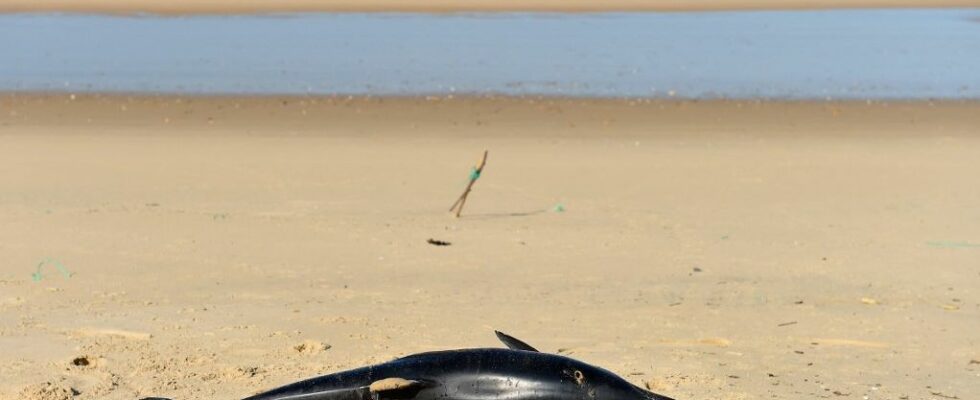How do you say “fillet” in dolphin? More than a word, it is an image sought by Bastien Mérigot, lecturer at the University of Montpellier, researcher at UMR Marbec, a marine biodiversity research unit. “To locate themselves and to detect their prey, dolphins use echolocation, he explains. They emit acoustic signals and receive echoes in return that they are a priori able to decode in image and thus obtain information about their environment”.
Bastien Mérigot then seeks to identify and reproduce the echo that these dolphins would have if they had emitted an echolocation signal on a net. “In other words, we are trying to make their work easier,” explains the biologist.
Strandings, visible part of the carnage
The project is called “Dolphin Free” and was launched in 2020. We know the context: massive strandings of common dolphins on our beaches, every year from December to April. If there have always been some, they have risen very sharply since 2016, notes the Pelagis observatory. Particularly on the Atlantic coast. There were 1,149 in 2019, 1,299 in 2020, 669 in 2021. “Since December, we have reached 450 and the stranding season is not over,” warns Cédric Marteau, director of the “Nature Protection” division. ” to the LPO. Just the emerged part of the hecatomb, he insists: “The majority of dolphins caught in the nets sink on the spot or are carried away by the currents towards the open sea”. “Pelagis estimates between around 4,000 and 8,000 the number of common dolphins killed by fishing each year in the Bay of Biscay in recent years”, confirms Bastien Mérigot.
There is little doubt about the cause of these strandings: “about 90% of the carcasses examined bear the marks of accidental fishing catches”, indicates Bastien Mérigot. But why especially since 2016? “We don’t really know,” he replies. This could be linked to the spatial redistribution, closer to the French coasts, of the fish populations on which the dolphins feed. Hake, bass, sole, pollock… The same ones that fishing boats target. Everyone finds themselves navigating the same corners, increasing the risk of interactions, which are often fatal for the dolphins.
Pingers on trawlers, nothing on gillnetters?
The solution may come from technology. The NGOs doubt it (see box). All the same, since 2020, the twelve pairs of pelagic trawlers active in the Bay of Biscay (from southern Finistère to the Basque Country) must be equipped with “pingers”. These acoustic repellents are installed on the boat and emit unpleasant sounds to the dolphins to keep them away. “Tests during the winter of 2017-2018, on pelagic trawls, showed reductions in accidental catches of 65% on average”, indicates Bastien Mérigot.
Better, but not perfect. Above all, pelagic trawls are not the only ones to criss-cross the Bay of Biscay. There are also the gillnets, these boats that deposit their nets on the seabed before returning to pick them up later. Bastien Mérigot speaks of 400 French ships in the area, “some using nets of several kilometers”. The requirement to equip repellent pingers does not apply to them. “They are too heavy for their nets and would impact fishing operations,” continues the biologist. The risk also, by equipping them all, would be to potentially exclude dolphins from areas that are too vast. »
Put yourself in the shoes of a dolphin
Several research programs have thus been launched with a view to adapting distancing devices to gillnetters. Urged by the European Union to actFrance updated in January its accidental capture control plan, which provides for the large-scale experimentation, next winter, of three of these projects.
DolphinFree is one of them and uses a new, bio-inspired approach. “The repellent signals are alarms: the dolphins move away because they are disturbed by the noise, but without having identified its meaning, explains Bastien Mérigot. Rather, we sought to produce an informative, understandable signal from common dolphins. »
Better, but not easy to develop, “if only because dolphins emit over a very wide frequency band, well beyond what our ears can hear”, specifies the biologist. A first step was to record dolphin echolocation signals. Then, Bastien Mérigot’s team went to sea to retransmit these signals on a net, as a dolphin would have done. “We still had to record the echo obtained in return, ie the acoustic signature of the net in dolphin language. It is this echo that our beacons emit. »
Less stressed dolphins?
The first feedback is encouraging. The beacons, in the shape of a tube, were tested at sea with around fifty groups of wild dolphins. “They communicate much more with each other and echolocate more after receiving our signal, which suggests that they have more possibilities of detecting the net and the associated dangers,” begins the researcher. Above all, unlike acoustic repellents, they leave the danger zone in a much calmer way to resume their activity a few hundred meters away, without being excluded from their habitat zones. A dozen gillnetters fitted their nets with these beacons between 2021 and 2022, allowing them to be tested in more than a thousand fishing operations. For zero accidental capture! “Well yes, three, rectifies Bastien Mérigot, But they were linked to fishing incidents. A net, for example, remained ten days at sea, unable to be recovered by the fishermen, the day after its launch. The beacon’s batteries eventually went flat. »
The scientist is working on a new version of his beacons, smaller and lighter, so that “fishermen can install and unhook them with as few constraints as possible”. The objective is to have it ready by December, the date scheduled for the start of the large-scale experimentation desired by the government. Sixty-three gillnet vessels will then test the beacons developed by Bastien Mérigot and his teams. Until the end of April 2024.

